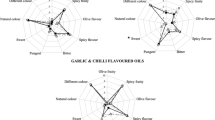Abstract
The chemical composition of four olive and four argan oils marketed in Morocco as extra-virgin oils was compared. Oxidative stability was also determined initially under accelerated conditions. Composition and oxidative stability of olive oils was found to be fluctuant and variety-dependent, whereas argan oil presents a profile that should more likely satisfy consumers eager to know the precise composition and nutritional property of their food.
Similar content being viewed by others
References
Dubois V, Breton S, Linder M et al (2007) Fatty acid profiles of 80 vegetable oils with regard to their nutritional potential. Eur J Lipid Sci Technol 109:710–732
Waterman E, Lockwood B (2007) Active components and clinical applications of olive oil. Altern Med Rev 12:331–342
Charrouf Z, Guillaume D (2008) Argan oil: occurrence, composition and impact on human health. Eur J Lipid Sci Technol 110:632–636
El Monfalouti H, Guillaume D, Denhez C et al (2010) Therapeutic potential of argan oil: a review. J Pharm Pharmacol 62:1669–1675
Mataix J, Battino M, Ramirez-Tortosa MC et al (2008) Virgin olive oil: a key healthy component of the Mediterranean diet. Mediterr J Nutr Metab 1:69–75
Charrouf Z, Guillaume D (2010) Should the amazigh diet (regular and moderate argan-oil consumption have a beneficial impact on human health? Crit Rev Food Sci Nutr 50:473–477
Ait Aabd N, El Ayadi F, Msanda F et al (2010) Genetic variability of argan tree and preselection of the candidate plus trees. Not Bot Hort Agrobot Cluj 38:293–301
Vossen P (2007) Olive oil: history, production, and characteristics of the world’s classic oils. HortScience 42:1093–1100
Smyth JD (2002) Perspectives of the Australian olive industry. Adv Hort Sci 3–4:280–288
Grigg D (2001) Olive oil, the Mediterranean and the world. GeoJournal 53:163–172
Perez-Jimenez F, Alvarez de Cienfuegos G, Badimon L et al (2005) International conference on the healthy effect of virgin olive oil. Eur J Clin Invest 35:421–424
Lopez-Miranda J, Pérez-Jiménez F, Ros E et al (2010) Olive oil and health: summary of the II international conference on olive oil and health consensus report, Jaén and Córdoba (Spain) 2008. Nutr Metab Cardiovasc Dis 20:284–294
Yousfi M, Bombarda I, Hamia C et al (2009) Fatty acid, triglyceride and tocopherol composition of Algerian argan (Argania spinosa) fruit seed lipids. Mediterr J Nutr Metab 2:197–203
Chimi H (2005) Conservations comparées de l’huile d’argane et de l’huile d’olive. Cahiers Agric 14:467–471
Commission Regulation (EEC) (1991) 2568/91 on the characteristics of olive oil and olive-residue oil and on the relevant methods of analysis. Off J Eur Commun L 248:1–82
Gharby S, Harhar H, Guillaume D et al (2011) Oxidative stability of edible argan oil: a 2 year study. LWT Food Sci Technol 44:1–8
American oil chemist’s society (1993) Determination of tocopherols and tocotrienols in vegetable oils and fats by HPLC. Uniform Methods Committee. AOCS Official Method Ce 8e89. Champaign, Il: AOCS
DGF (2008) Deutsche Einheitsmethoden zur Untersuchung von Fetten, Fettprodukten, Tensiden und verwandten Stoffen. Stuttgart: Wissenschaftliche Verlagsgesellschaft
Codex Alimentarius Commission, Stan 33, 1981, revised 2-, 2003 Codex Alimentarius Commission (2003) (CODEX Stan 33, 1981, revised 2-2003). CODEX Standard for olive oils and olive pomace oils. Food and Agriculture Organization of the United Nations, Rome
Service de Normalisation Industrielle Marocaine (SNIMA) (2003) Huiles d’argane. Spécifications. Norme marocaine NM 08.5.090 Rabat: Snima, 2003
Aparicio R, Luna G (2002) Characterisation of monovarietal virgin olive oils. Eur J Lipid Sci Technol 104:614–627
Acknowledgments
We thank Lesieur-Cristal, cooperatives Targant (Ait Baha), Taitmatine (Tiout), and Tidzi-cooperative for their financial support and assistance in this work; respectively.
Conflict of interest
None.
Author information
Authors and Affiliations
Corresponding author
About this article
Cite this article
Gharby, S., Harhar, H., El Monfalouti, H. et al. Chemical and oxidative properties of olive and argan oils sold on the Moroccan market. A comparative study. Mediterr J Nutr Metab 5, 31–38 (2012). https://doi.org/10.1007/s12349-011-0076-5
Received:
Accepted:
Published:
Issue Date:
DOI: https://doi.org/10.1007/s12349-011-0076-5




